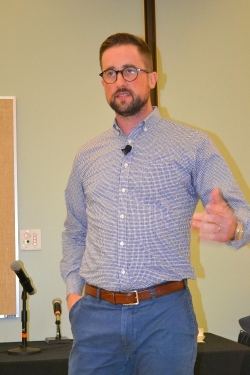 In Austin Eubanks’ mind, addiction was something that was never supposed to happen to him.
In Austin Eubanks’ mind, addiction was something that was never supposed to happen to him.
The chief operations officer for Foundry Treatment Center in Colorado served as the keynote speaker for day one of the 2018 Susan Li Conference hosted by Hope Academy and Fairbanks.
Eubanks had good parents, no familial history of addiction and spent part of his adolescence in a small, tightknit community in Oklahoma.
His dad, an engineer, moved the family to Denver for a new job when Eubanks was 11. Going from a rural area to a big city proved to be a culture shock for Eubanks. He struggled with fitting in at his new, much larger school, and lost his sense of identity. By the time Eubanks was ready to start high school, he had convinced his parents to allow him to enroll in an out-of-district school. His choice: Columbine High School.
It started off as a good change for Eubanks. He made friends his freshman year, including with Corey DePooter, who became his best friend. They experienced some of adolescence’s biggest milestones together and both loved fishing and golf.
Everything changed on April 20, 1999. That was the day two students walked into Columbine and proceeded to kill 12 students and a teacher and injure 21 before committing suicide. Eubanks and DePooter were in the school library when they heard gunshots. Students were hiding under tables when the shooters entered the library. Eubanks was shot in the hand and knee. DePooter was shot in the chest and neck and died instantly. Eubanks recalls the tragedy as if he was disassociated from his body.
“It’s like I was watching it on TV,” he said. “I was in complete shock.”
Eubanks’ first emotion in the immediate aftermath was not until he saw his father jumping a fence to reach him. At that point he became hysterical. He was heavily medicated with narcotics at the hospital.
“It was like having a warm blanket put over me when I needed a warm blanket,” Eubanks said.
He had never so much as taken a sip of alcohol or smoked a cigarette prior to the Columbine massacre. Afterward? It was a 180. Eubanks says his physical pain was gone after just a few days. His emotional pain was a whole other situation.
“Anything that allowed me to not feel present and detach from myself, I wanted more of it,” he said.
Eubanks tried to go back to Columbine for his senior year, but couldn’t overcome his trauma. He used a private tutor instead, which gave him even more time to abuse the prescription opioids he was still taking.
“I blocked myself off from human connection while a lot of my classmates healed together,” Eubanks said of that time in his life.
Despite not going to college, he was able to build a career in advertising thanks to teaching himself website design and coding. Eubanks married young and had two sons. He also continued his substance abuse. At its worst he was taking 400 milligrams of Oxycontin daily.
His rock bottom happened at age 29, when Eubanks woke up in a Denver jail cell and didn’t remember how he got there.
“My life was Grand Theft Auto without the controller,” he said.
Eubanks started rebuilding his life after staying 14 months at Stout Street Foundation, a 180-bed therapeutic community in Denver that primarily serves an indigent population. He’s now on Stout Street’s board, along with a public charter school in Denver that focuses on prevention and addiction recovery in adolescents.
As a recovery advocate, Eubanks emphasizes addressing the demand for addictive substances rather than the supply, and establishing prevention efforts in our children’s lives at much younger ages. It’s not just opioids and illicit drugs that are fueling today’s addictions. Eubanks believes everything we use in our daily lives – from smartphones to social media – is designed to make us addicted to using it. Indeed, technology is such today that younger generations primarily get all their illegal drugs off the dark web.
Add to that the fact that toxicity in illicit drugs continues to grow, and Eubanks said, “We’re programming an entire generation to addictive behavior, at a time when drugs are more plentiful and deadlier than ever. We’re more disconnected as a culture than we’ve ever been. The only way forward is how we respond to the demand, starting with our youth.”